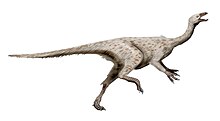Beishanlong
| Beishanlong Temporal range: Early Cretaceous,
| |
|---|---|

| |
| Scientific classification | |
| Domain: | Eukaryota |
| Kingdom: | Animalia |
| Phylum: | Chordata |
| Clade: | Dinosauria |
| Clade: | Saurischia |
| Clade: | Theropoda |
| Clade: | †Ornithomimosauria |
| Family: | †Deinocheiridae |
| Genus: | †Beishanlong Makovicky et al., 2010 |
| Species: | †B. grandis
|
| Binomial name | |
| †Beishanlong grandis Makovicky et al., 2010
| |
Beishanlong is a genus of giant ornithomimosaurian theropod dinosaur from the Early Cretaceous of China.
Discovery and naming
Three fossils of Beishanlong were in the early twenty-first century found in northwestern China at the White Ghost Castle site, in the province of Gansu. The type species is Beishanlong grandis, described and named online in 2009 by a team of Chinese and American paleontologists, and formally published in January 2010 by the same Peter Makovicky, Li Daiqing, Gao Keqin, Matthew Lewin, Gregory Erickson and Mark Norrell. The generic name combines a references to the Bei Shan, the "White Mountains", with a Chinese long, "dragon". The specific name means "large" in Latin, in reference to the body size.[1]
Beishanlong lived at the boundary of the Aptian to Albian stages, around 120 million years ago. Its fossils were uncovered in layers of the Xinminpu Group. The holotype is FRDC-GS GJ (06) 01-18, found in 2006, consisting of a partial skeleton lacking the skull.[1] The paratypes consist of two specimens found in 2007: one consisting of remains of hindlimbs, the other, FRDC-GS JB(07)01-01, being a pair of pubes. A fourth fossil found in 1999, IVPP V12756 consisting of foot bones, was tentatively referred to the species.[1]
Description
Beishanlong is of a considerable size, approximating the largest known individuals of Gallimimus, which have been estimated at eight metres. According to the description, Beishanlong "is one of the largest definitive ornithomimosaurs yet described, though histological analysis shows that the holotype individual was still growing at its death." Extrapolating from the sixty-six centimetres long thighbone, the describers estimated the weight at 626 kilogrammes.[1] Gregory S. Paul in 2010 gave an estimate of seven metres length and five hundred fifty kilogrammes.[2] A histological study of the bone structure of the fibula found thirteen or fourteen growth lines, indicating the individual was subadult, though growth had already slowed.[1]
The build of Beishanlong was rather robust. The arms and legs were long, though lacking the extremely elongated hands, feet and claws of later forms.[1]
Classification
Beishanlong was by the describers assigned to the Ornithomimosauria, in a more basal position. Beishanlong was closely related to fellow ornithomimosaurian Harpymimus. Together they formed a polytomy with the main ornithomimosaurian branch just below Garudimimus.[1]
References
- ^ a b c d e f g Makovicky, Peter J.; Li, Daqing; Gao, Ke-Qin; Lewin, Matthew; Erickson, Gregory M.; Norell, Mark A. (2010). "A giant ornithomimosaur from the Early Cretaceous of China". Proceedings of the Royal Society B: Biological Sciences. 277 (1679): 191–198. doi:10.1098/rspb.2009.0236.
- ^ Paul, G.S., 2010, The Princeton Field Guide to Dinosaurs, Princeton University Press p. 112
External links
- "Field Museum palaeontologist leads study on two new dinosaurs from China" ScienceCentric.com
